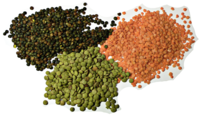
Photo from wikipedia
Legumes have been sought as alternative protein sources to ensure food security and environmental sustainability. Characterizing their protein content and quality, including in underutilized grain legumes, e.g., grass pea, gives… Click to show full abstract
Legumes have been sought as alternative protein sources to ensure food security and environmental sustainability. Characterizing their protein content and quality, including in underutilized grain legumes, e.g., grass pea, gives value to the legumes’ underexplored variability. To fill the gap of knowledge in legumes’ protein quality, for the first time, five extensive collections of cool season grain legumes were cropped under the same environmental conditions and further analyzed. Multivariate analysis showed the existent intra- and inter-species variability. The legume species with the highest protein content, grass pea, Lathyrus sativus (LS), was not the one with the overall highest individual amino acids content and in vitro protein digestibility. With these last characteristics lentil, Lens culinaris (LC), was highlighted. The highest average values of arginine (Arg), glutamic acid (Glu), and threonine (Thr) were found in LS and Vicia faba (VF). Cicer arietinum (CA) stood out as the species with the highest values of Thr and methionine (Met). Regarding the in vitro protein digestibility (IVPD), LC, followed by Pisum sativum (PS) and LS, were the legume species with the highest values. Ultimately, this study bought to the fore legume species that are not commonly used in western diets but have high adaptability to the European agricultural systems.
Journal Title: Foods
Year Published: 2023
Link to full text (if available)
Share on Social Media: Sign Up to like & get
recommendations!